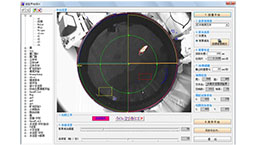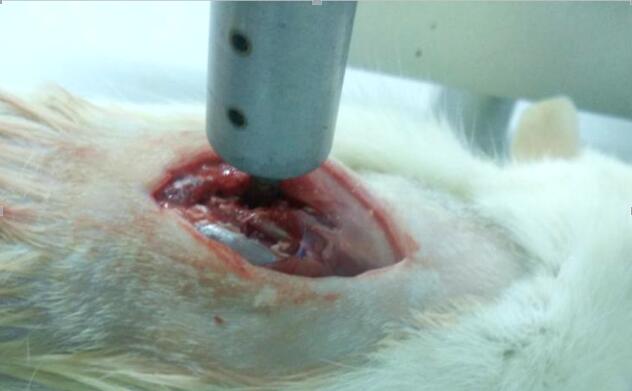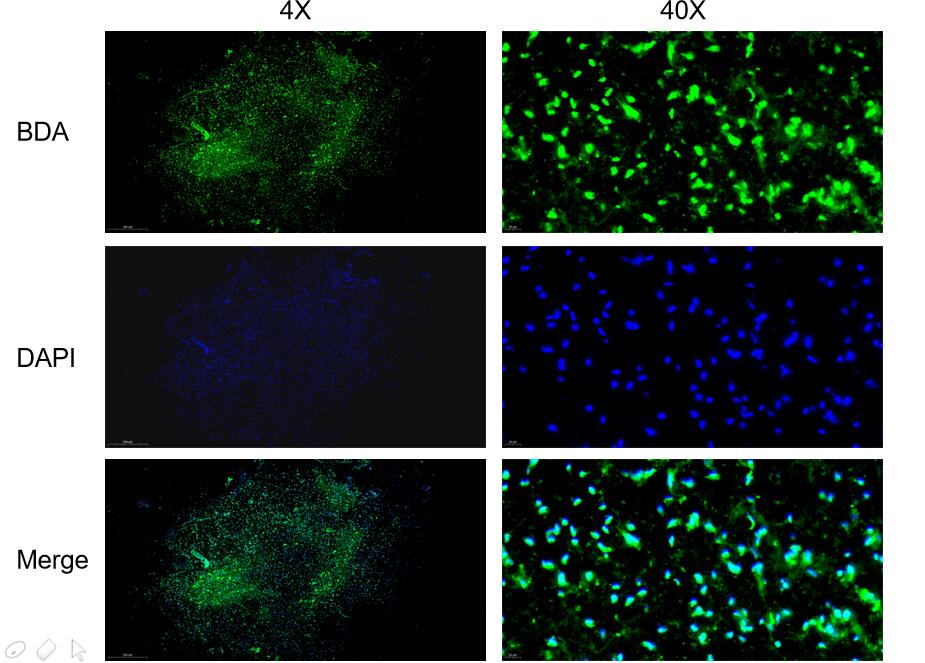Rat Model for Actue Spinal Cord Injury (ASCI)
Traumatic Spinal Cord Injury
- Product No.DSI545Ra01
- Organism SpeciesRattus norvegicus (Rat) Same name, Different species.
- Prototype SpeciesHuman
- SourceSpinal cord injury (SCI) induced by Allen 's method
- Model Animal StrainsWistar Rat, healthy, male, bodyweight:180g~200g
- Modeling GroupingRandomly divided into six group: Control group, Model group, Positive drug group and Test drug group (three doses).
- Modeling Period4w
- Modeling Method1. Rats were anesthetized with chloral hydrate (350mg/kg), and fixed in the prone position on the operating plate. The rib and soft tissue boundaries at the back of both sides of the dorsal spinal cord to touch the bottom of the rib and soft tissue, as as bony landmarks, to the upper and lower 5 cm, after depilation routine sterilization, sterile operation, the posterior midline longitudinal incision, about 3cm, in turn cut the skin, subcutaneous fascia, exposed paraspinal muscle, joppien of tenth thoracic vertebrae the spinous process, blunt dissection of muscle exposed spinous process, lamina and transverse process.
Reference location: T9 spinous process tends to caudal, T10 spinous process neutral, T11 spinous process tends to the cephalic.
2.Determine the T10 thoracic position, do two transverse cut between T9 and T10, T10 and T11 spinous process and lamina shear with corresponding bone in T10 thoracic transverse process on both sides, and veterbral plate longitudinal cutting, forming a square cut in line, and then use the rongeur bite T10 thoracic spine with the sudden force pull‘uncovery’, the removal of T10 lamina, forming square bone window, repairment of window edge, fully exposed the corresponding spinal cord T10.
3.With the Allen's impactor preparation of animal models of spinal cord injury, opening the soft tissue on retractoron both sides of spinal cord, traction and fixation, spinal stability, not affected by respiratory, the hit stick (20g) fallen from the height of 3cm,free fall, the damage energy of 60g·cm, impact the spinal cord corresponding to the T10 bone window, causing acute spinal cord injury, the hit stick should stay 3 mins and then move away.
4.Impact success criteria: impact of spinal cord edema, hemorrhage, dural integrity was purple, tense, bulging, rat tail spastic swing, lower limbs like a body retraction flutter, delayed paralysis. After conventional suture.
5.After 4 weeks, the rats were fixed on the fixed plate, exposing the spinal cord of T8~T12, remove the spinal cord tissue, 4% paraformaldehyde fixed 4 hrs, paraffin section (4um thick), HE staining to observe the pathological changes. - ApplicationsDisease Model
- Downloadn/a
- UOM Each case
- FOB
US$ 240
For more details, please contact local distributors!
Model Evaluation
1.General observation: the rats showed body spastic fibrillation, tail spastic swing, lower limbs and body retraction like flutter. After awakening from anesthesia rats showed flaccid paralysis of lower limbs, can appear urinary retention or incontinence. Anatomy of the spinal cord in rats after traumatic, can be observed hyperemia or edema.
Pathological Results
HE staining can be observed in the sham operation group of gray and white matter structure integrity, nerve cell distribution and cell bodies in the gray matter full, normal morphology, cell membrane integrity, white matter nerve fibers arranged neatly, interstitial cells evenly. In the SCI group, the gray and white matter structure was not complete, and the gray matter in the injury area showed massive hemorrhage, large necrotic foci, swelling of the cells, some of which appeared in the cavity, and the irregular arrangement of nerve fibers in the white matter.
Cytokines Level
Statistical Analysis
SPSS software is used for statistical analysis, measurement data to mean ± standard deviation (x ±s), using t test and single factor analysis of variance for group comparison, P<0.05 indicates there was a significant difference, P<0.01 indicates there are very significant differences.
GIVEAWAYS
INCREMENT SERVICES
-
 Tissue/Sections Customized Service
Tissue/Sections Customized Service
-
 Serums Customized Service
Serums Customized Service
-
 Immunohistochemistry (IHC) Experiment Service
Immunohistochemistry (IHC) Experiment Service
-
 Small Animal Micro CT Imaging Experiment Service
Small Animal Micro CT Imaging Experiment Service
-
 Small Animal MRI Imaging Experiment Service
Small Animal MRI Imaging Experiment Service
-
 Small Animal Ultrasound Imaging Experiment Service
Small Animal Ultrasound Imaging Experiment Service
-
 Transmission Electron Microscopy (TEM) Experiment Service
Transmission Electron Microscopy (TEM) Experiment Service
-
 Scanning Electron Microscope (SEM) Experiment Service
Scanning Electron Microscope (SEM) Experiment Service
-
 Learning and Memory Behavioral Experiment Service
Learning and Memory Behavioral Experiment Service
-
 Anxiety and Depression Behavioral Experiment Service
Anxiety and Depression Behavioral Experiment Service
-
 Drug Addiction Behavioral Experiment Service
Drug Addiction Behavioral Experiment Service
-
 Pain Behavioral Experiment Service
Pain Behavioral Experiment Service
-
 Neuropsychiatric Disorder Behavioral Experiment Service
Neuropsychiatric Disorder Behavioral Experiment Service
-
 Fatigue Behavioral Experiment Service
Fatigue Behavioral Experiment Service
-
 Nitric Oxide Assay Kit (A012)
Nitric Oxide Assay Kit (A012)
-
 Nitric Oxide Assay Kit (A013-2)
Nitric Oxide Assay Kit (A013-2)
-
 Total Anti-Oxidative Capability Assay Kit(A015-2)
Total Anti-Oxidative Capability Assay Kit(A015-2)
-
 Total Anti-Oxidative Capability Assay Kit (A015-1)
Total Anti-Oxidative Capability Assay Kit (A015-1)
-
 Superoxide Dismutase Assay Kit
Superoxide Dismutase Assay Kit
-
 Fructose Assay Kit (A085)
Fructose Assay Kit (A085)
-
 Citric Acid Assay Kit (A128 )
Citric Acid Assay Kit (A128 )
-
 Catalase Assay Kit
Catalase Assay Kit
-
 Malondialdehyde Assay Kit
Malondialdehyde Assay Kit
-
 Glutathione S-Transferase Assay Kit
Glutathione S-Transferase Assay Kit
-
 Microscale Reduced Glutathione assay kit
Microscale Reduced Glutathione assay kit
-
 Glutathione Reductase Activity Coefficient Assay Kit
Glutathione Reductase Activity Coefficient Assay Kit
-
 Angiotensin Converting Enzyme Kit
Angiotensin Converting Enzyme Kit
-
 Glutathione Peroxidase (GSH-PX) Assay Kit
Glutathione Peroxidase (GSH-PX) Assay Kit
-
 Cloud-Clone Multiplex assay kits
Cloud-Clone Multiplex assay kits
| Catalog No. | Related products for research use of Rattus norvegicus (Rat) Organism species | Applications (RESEARCH USE ONLY!) |
| DSI545Ra02 | Rat Model for Actue Spinal Cord Injury (ASCI) | n/a |
| DSI545Ra01 | Rat Model for Actue Spinal Cord Injury (ASCI) | Disease Model |
| TSI545Ra35 | Rat Spinal Cord Tissue of Actue Spinal Cord Injury (ASCI) | Paraffin slides for pathologic research: IHC,IF and HE,Masson and other stainings |







